igneous rocks
metamorphic
rocks
sedimentary rocks
|
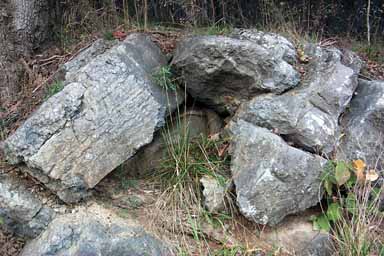
Composition
Fossils, some whole some fragmented, cemented by a spar matrix (crystalline calcite). Most of the fossils are crinoid stem fragments, but favositid (honeycomb) corals and stromatoporoids are also common.
Description
Coarse, rough rock with abundant fossils weathering out. Simplistically it is a fossil limestone, but technically it is called a packed biosparite. Packed because it is packed full of skeletons, biological fossils, sparite calcite cement between the skeletons. This is also a coarse, poorly sorted rock, with skeletons of many different sizes jumbled together. A number of scours, erosion surfaces, are also visible indicating periods of very strong currents, most likely storms.
The next several images will take you in closer and closer to the rock, primarily on the left side of the outcrop. Clicking the pictures will cycle you through them.
Tectonic Association
carbonates of all types are commonly associated with regions of tectonic stability and tropical climates, that is no mountain building, and stable, shallow water environments associated with continental shelves or epeiric (epicontinental) seas.
Formation & Environments
This outcrop is either a reef, or is closely associated with a reef. It was a high energy environment as indicated by the lack of fine grained sediment (micrite), and the presence of spar cement. Spar is crystalline calcite crystals precipitated by ground water in the spaces between the fossils after deposition.
Before this became a rock we can imagine it as a rubble pile of skeletons lying on the bottom with no other sediment intermixed with them.
Detail
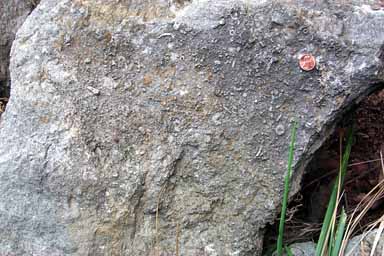
Composition
Fossils, some whole some fragmented, cemented by a spar matrix (crystalline calcite). Most of the fossils are crinoid stem fragments, but favositid (honeycomb) corals and stromatoporoids are also common.
Description
A close-up of the left side of the outcrop. Here we begin to see some of the fossils become visisble.
Further Detail
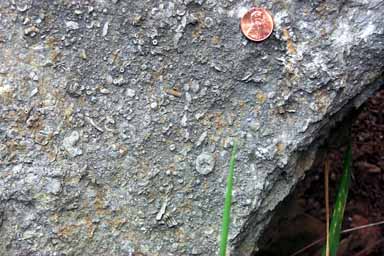
Composition
Fossils, some whole some fragmented, cemented by a spar matrix (crystalline calcite). Most of the fossils are crinoid stem fragments, but favositid (honeycomb) corals and stromatoporoids are also common.
Description
These are mostly crinoid stem fragments. Crinoids, also called sea lilies, are echinoderms (related to star fish). The calyx (body with feeding arms) was supported above the bottom on a stem composed of small calcite discs stacked together similar to a stack of pocker chips. When the animal died and decayed the individual stem discs would separate and be washed around on the bottom. Here we see a scattered collection of various size discs, some on end view (appearing round) and some in side view (appearing rectangular).
Further Detail
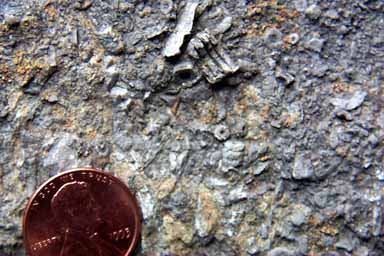
Composition
Fossils, some whole some fragmented, cemented by a spar matrix (crystalline calcite). Most of the fossils are crinoid stem fragments, but favositid (honeycomb) corals and stromatoporoids are also common.
Description
Crinoid stem fragments now easy to see.
Another Sample
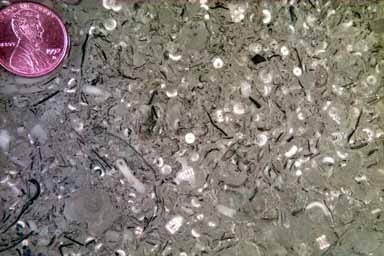
Composition
micrite = lime mud; CaCO3, the mineral calcitesurrounding and supporting skeletons, mostly of crinoids (white fragments) and brachiopods (black, curved fragments), although bryozoans and other organisms are present.
Description
Saw cut slab of limestone, wet with water before being photographed. Black and white objects are cut sections of fossils. The white pieces are mostly crinoid stem fragments. Crinoids stems are cylindrical columns made up of discs strung together like a stack of poker chips. Sometimes they appear round when the stem has been cut across the axis, while longitudinal cuts are rectangular.
The curved black fossils are cross sections through brachiopods or trilobites.
The light gray areas are the unform, dense micrite.
Tectonic Association
carbonates of all types are commonly associated with regions of tectonic stability and tropical climates, that is no mountain building, and stable, shallow water environments associated with continental shelves or epeiric (epicontinental) seas.
Formation & Environments
This rock was deposited in a shelf environment in an epicontinental sea (one lying on a continent). The water was quiet for the most part, as indicated by the abundant micrite matrix, but was a rich place for life as indicated by the abundant fossils. As the animals died their skeletons would accumulate on the bottom, and be slowly buried by the micrite.
Detail
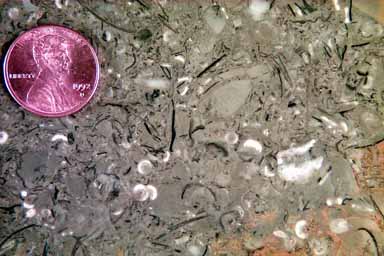
Composition
micrite = lime mud; CaCO3, the mineral calcitesurrounding and supporting skeletons, mostly of crinoids (white fragments) and brachiopods (black, curved fragments), although bryozoans and other organisms are present.
Description
Saw cut slab of limestone, wet with water before being photographed. Black and white objects are cut sections of fossils. The white pieces are mostly crinoid stem fragments. Crinoids stems are cylindrical columns made up of discs strung together like a stack of poker chips. Sometimes they appear round when the stem has been cut across the axis, while longitudinal cuts are rectangular.
The curved black fossils are cross sections through brachiopods or trilobites.
The light gray areas are the unform, dense micrite.
Further Detail
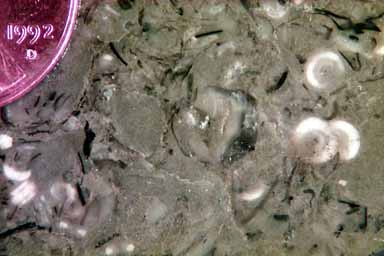
Composition
micrite = lime mud; CaCO3, the mineral calcitesurrounding and supporting skeletons, mostly of crinoids (white fragments) and brachiopods (black, curved fragments), although bryozoans and other organisms are present.
Description
Saw cut slab of limestone, wet with water before being photographed. Black and white objects are cut sections of fossils. The white pieces are mostly crinoid stem fragments. Crinoids stems are cylindrical columns made up of discs strung together like a stack of poker chips. Sometimes they appear round when the stem has been cut across the axis, while longitudinal cuts are rectangular.
The curved black fossils are cross sections through brachiopods or trilobites or trilobites.
The light gray areas are the unform, dense micrite.
|